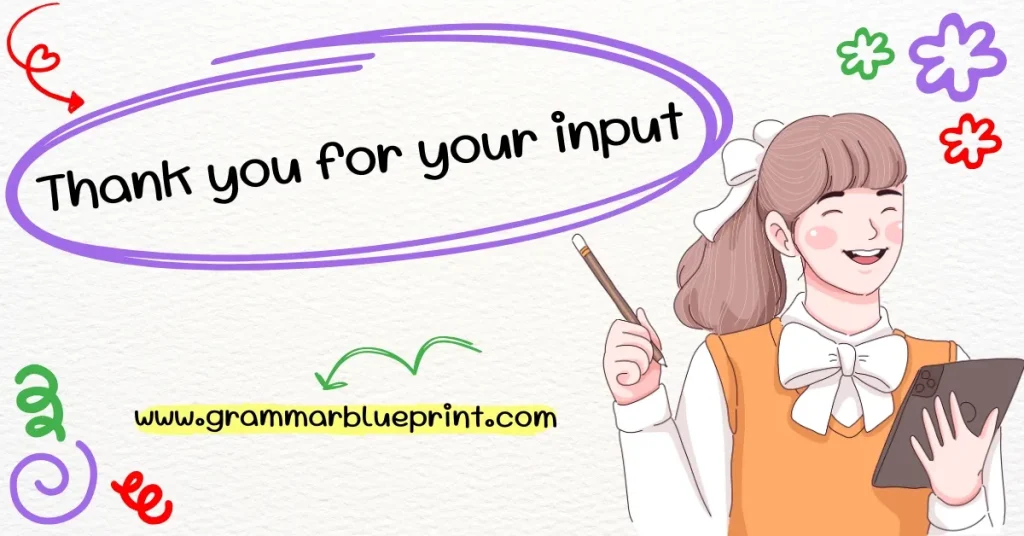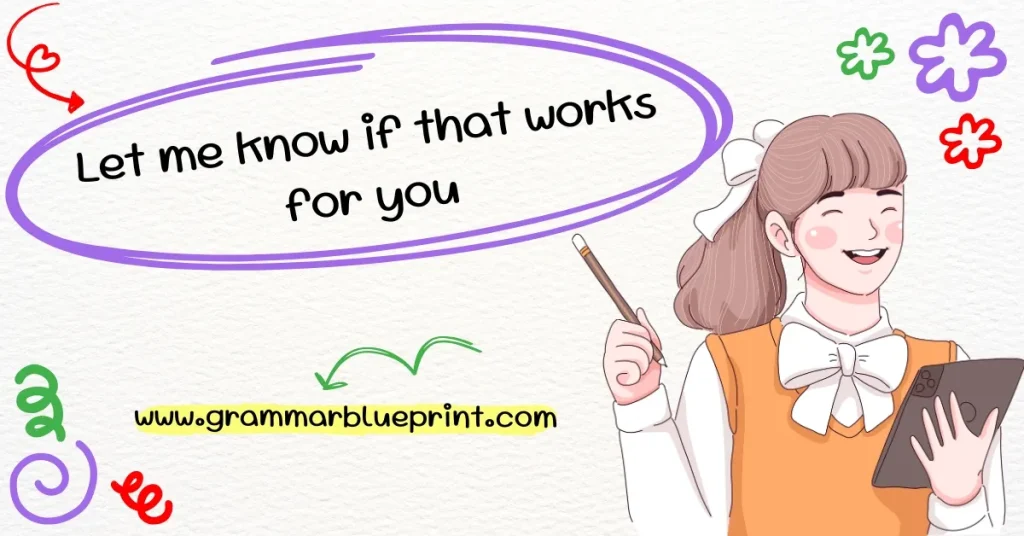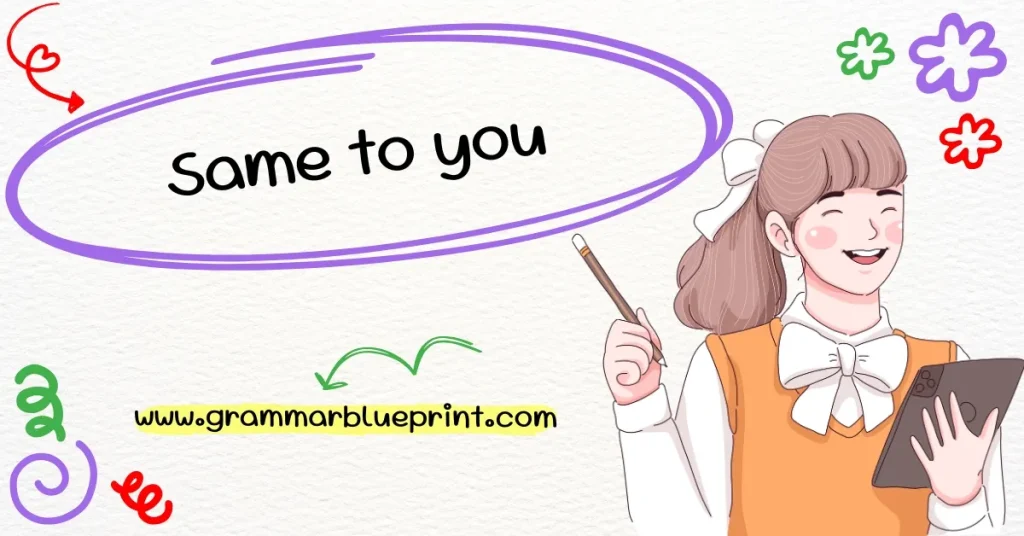The phrase “thank you for your input” is commonly used to express appreciation for someone’s thoughts, suggestions, or feedback. It’s a polite way to acknowledge others’ contributions, and it can play a significant role in enhancing communication, both in professional and casual settings.
What is “Thank You for Your Input”?
“Thank you for your input” is a phrase used to express gratitude for someone’s thoughts, ideas, or feedback. It’s typically employed after someone has shared their opinion or advice in discussions or meetings. The phrase shows respect for their time and contributions. Whether you’re working on a project with colleagues or seeking feedback on an idea, saying “thank you for your input” is a polite and effective way to acknowledge the value of others’ perspectives.
This phrase is flexible and can be used in both formal and informal settings. It is versatile enough to work in professional emails, casual conversations with friends, or academic group discussions.
Why Use “Thank You for Your Input”?
Saying “thank you for your input” serves several purposes. Primarily, it shows appreciation for the time and effort someone has spent offering feedback or advice. Whether you’re dealing with feedback in a meeting or receiving help with a project, this phrase helps reinforce positive communication and strengthens relationships.
In professional settings, using this phrase can improve workplace culture by encouraging people to share their thoughts more openly. It fosters an atmosphere of mutual respect, where every voice is heard, contributing to a more collaborative environment. Furthermore, showing appreciation enhances communication by making it clear that the feedback is valued, thus encouraging ongoing engagement and conversation.
Benefits of Saying “Thank You for Your Input”
- Strengthening Professional Relationships
Using this phrase helps create a more respectful and collaborative environment. Acknowledging someone’s input shows them that you value their time and effort, which in turn builds trust and rapport.
- Encouraging Continued Feedback and Conversation
When you appreciate someone’s feedback, you encourage them to share more in the future. It sets a positive tone for continuous communication, making people feel more comfortable contributing their thoughts.
- Enhancing Active Listening and Engagement
Saying “thank you for your input” signals that you’re actively listening and genuinely interested in others’ opinions. It helps create an open dialogue where all participants feel engaged and valued.
How to Use “Thank You for Your Input” in Different Settings
- In Professional Communication
- Emails: After receiving feedback or suggestions via email, it’s important to acknowledge it. You can simply reply with, “Thank you for your input, it’s much appreciated,” to show appreciation for the effort someone took to contribute their thoughts.
- Meetings: If you’re in a meeting and someone offers valuable suggestions or comments, saying “thank you for your input” shows you’re attentive and respectful toward others’ perspectives.
- Work Conversations: In team discussions, when colleagues share their thoughts or solutions to a problem, thanking them for their input reinforces the value of their contribution.
- Emails: After receiving feedback or suggestions via email, it’s important to acknowledge it. You can simply reply with, “Thank you for your input, it’s much appreciated,” to show appreciation for the effort someone took to contribute their thoughts.
- In Informal Settings
- With Friends or Family: This phrase can also be used casually in personal settings. For example, if a friend offers a suggestion or an idea, saying “thank you for your input” expresses gratitude in a friendly and genuine way.
- Casual Conversations: When someone shares their thoughts on a topic, you can casually reply with, “Thanks for your input, I really appreciate it.”
- With Friends or Family: This phrase can also be used casually in personal settings. For example, if a friend offers a suggestion or an idea, saying “thank you for your input” expresses gratitude in a friendly and genuine way.
- In Academic Contexts
- Acknowledging the contributions of classmates or group members in academic settings is equally important. “Thank you for your input” can be used to thank someone for their ideas in class discussions or group projects. It shows respect and keeps the academic environment positive.
- Acknowledging the contributions of classmates or group members in academic settings is equally important. “Thank you for your input” can be used to thank someone for their ideas in class discussions or group projects. It shows respect and keeps the academic environment positive.
Common Mistakes to Avoid
While saying “thank you for your input” is a polite way to show appreciation, there are a few common mistakes to avoid:
- Overusing the Phrase or Sounding Insincere
It’s important not to overuse the phrase, as it can come across as robotic or lacking genuine appreciation. Ensure that it fits naturally in the context and that you truly value the feedback received.
- Using It in the Wrong Context
Sometimes, “thank you for your input” may not be the best phrase to use, especially in situations where the feedback was inappropriate or unhelpful. In such cases, it may be better to acknowledge the feedback briefly or redirect the conversation toward a more constructive direction.
Better Alternatives to Say “Thank You for Your Input”
If you’re looking for variety or want to express appreciation in different ways, here are some alternatives to “thank you for your input.” For each alternative, we’ll explore its meaning, usage, and the tone it conveys.
“I Appreciate Your Feedback”
-
- Meaning: A direct and clear way of showing that you value someone’s opinion.
- Best Use: Suitable in both formal and informal settings when someone provides valuable feedback.
- Tone: Grateful, professional.
- Meaning: A direct and clear way of showing that you value someone’s opinion.
“Thanks for Your Thoughts”
-
- Meaning: A lighter, more informal way to show appreciation.
- Best Use: Casual conversations, especially with friends or colleagues.
- Tone: Friendly, conversational.
- Meaning: A lighter, more informal way to show appreciation.
“I’m Grateful for Your Suggestions”
-
- Meaning: A formal expression of appreciation for suggestions offered.
- Best Use: Professional emails or meetings when someone suggests ways to improve a project.
- Tone: Formal, respectful.
- Meaning: A formal expression of appreciation for suggestions offered.
“Thank You for Sharing Your Insights”
-
- Meaning: Acknowledges someone’s deeper understanding or unique perspective.
- Best Use: Used when someone provides in-depth analysis or advice.
- Tone: Appreciative, thoughtful.
- Meaning: Acknowledges someone’s deeper understanding or unique perspective.
“I Value Your Opinion”
-
- Meaning: Indicates that you hold someone’s opinion in high regard.
- Best Use: Used in professional and personal conversations where you respect the other person’s views.
- Tone: Respectful, sincere.
- Meaning: Indicates that you hold someone’s opinion in high regard.
“Thanks for Your Perspective”
-
- Meaning: Acknowledges the personal point of view someone brings to the table.
- Best Use: In meetings or group discussions when a new perspective is shared.
- Tone: Appreciative, neutral.
- Meaning: Acknowledges the personal point of view someone brings to the table.
“I’m Thankful for Your Feedback”
-
- Meaning: A straightforward expression of gratitude.
- Best Use: Professional settings, especially after receiving feedback in emails or meetings.
- Tone: Polite, professional.
- Meaning: A straightforward expression of gratitude.
“Your Input is Much Appreciated”
-
- Meaning: Shows that you value and respect the contribution made.
- Best Use: When you want to emphasize the value of someone’s input.
- Tone: Formal, respectful.
- Meaning: Shows that you value and respect the contribution made.
“Thanks for Your Time and Input”
-
- Meaning: Acknowledges both the effort and time someone spent offering feedback.
- Best Use: Professional emails or meetings where someone’s time is acknowledged.
- Tone: Appreciative, polite.
- Meaning: Acknowledges both the effort and time someone spent offering feedback.
“I Appreciate Your Comments”
- Meaning: Acknowledge comments made in feedback or discussions.
- Best Use: In casual or formal settings when feedback comes in the form of comments.
- Tone: Neutral, polite.
“I’m Grateful for Your Ideas”
- Meaning: Expresses gratitude for someone’s creative thoughts or suggestions.
- Best Use: Ideal in professional brainstorming sessions or when someone shares innovative ideas.
- Tone: Grateful, respectful.
“Thanks for Your Assistance”
- Meaning: Acknowledges someone’s help or support in a task.
- Best Use: When someone helps you in completing a job or project.
- Tone: Professional, polite.
“I Appreciate Your Perspective”
- Meaning: Acknowledges the unique point of view someone offers.
- Best Use: In discussions or debates where different opinions are being shared.
- Tone: Respectful, thoughtful.
“Your Input is Valuable, Thank You”
- Meaning: Highlights that the feedback given is highly valued.
- Best Use: When you want to emphasize how much you appreciate someone’s contribution.
- Tone: Formal, appreciative.
“Thank You for Taking the Time to Share”
- Meaning: Shows appreciation for someone’s effort in contributing their feedback.
- Best Use: When someone takes time out of their schedule to offer feedback or suggestions.
- Tone: Grateful, thoughtful.
“Thanks for Your Thoughts on This”
- Meaning: Acknowledges the ideas or suggestions someone provides.
- Best Use: In both casual and formal settings when someone shares their opinion.
- Tone: Friendly, casual.
“I’m Thankful for Your Feedback”
- Meaning: A simple, direct expression of gratitude for someone’s feedback.
- Best Use: In professional settings, especially after receiving comments or suggestions on a project.
- Tone: Professional, sincere.
“Your Contribution is Much Appreciated”
- Meaning: Acknowledges that the person’s feedback or effort is valuable.
- Best Use: When someone has contributed significantly to a conversation or project.
- Tone: Formal, respectful.
“Thanks for Your Advice”
- Meaning: Shows gratitude for receiving guidance or advice.
- Best Use: When someone provides helpful recommendations.
- Tone: Polite, appreciative.
“Your Feedback Has Been Helpful, Thank You”
- Meaning: Acknowledges that the feedback provided has made a positive impact.
- Best Use: After receiving useful advice or recommendations.
- Tone: Grateful, positive.
“Thanks for Your Thoughtful Contribution”
- Meaning: Expresses gratitude for someone’s well-considered input.
- Best Use: When someone provides detailed or thoughtful feedback.
- Tone: Appreciative, reflective.
“I Appreciate Your Comments”
- Meaning: Acknowledge comments made in feedback or discussions.
- Best Use: In casual or formal settings when feedback comes in the form of comments.
- Tone: Neutral, polite.
“Thank You for Helping Out”
- Meaning: Shows appreciation for someone’s assistance or support.
- Best Use: Informal settings or when someone helps you in a non-professional task.
- Tone: Casual, friendly.
“I’m Grateful for Your Suggestions”
- Meaning: Acknowledges someone’s suggestions with gratitude.
- Best Use: In professional and casual discussions when suggestions are offered.
- Tone: Grateful, respectful.
“Thanks for Your Help and Input”
- Meaning: Expresses appreciation for both help and suggestions offered.
- Best Use: When someone contributes both practical help and feedback.
- Tone: Polite, appreciative.
“I Appreciate Your Feedback and Ideas”
- Meaning: Combines gratitude for both feedback and creative input.
- Best Use: In brainstorming sessions, meetings, or discussions where both ideas and feedback are shared.
- Tone: Grateful, inclusive.
“Your Suggestions Are Valuable, Thank You”
- Meaning: Acknowledges that the suggestions given are of great importance.
- Best Use: When someone offers ideas that could significantly improve a project or task.
- Tone: Professional, appreciative.
“Thanks for Taking Part in the Discussion”
- Meaning: Acknowledges someone’s participation in a conversation or meeting.
- Best Use: After a discussion or meeting where multiple participants contributed their views.
- Tone: Friendly, respectful.
“I’m Thankful for Your Time and Insight”
- Meaning: Expresses gratitude for both the time and valuable insights provided.
- Best Use: In professional settings, especially after receiving advice or feedback that required significant time or effort.
- Tone: Appreciative, professional.
“Thanks for Your Contributions”
- Meaning: Acknowledges that someone has contributed in a meaningful way.
- Best Use: After a team meeting, brainstorming session, or collaborative project.
- Tone: Respectful, appreciative.
Detailed Explanation for Each Alternative: For every alternative, you’ll find context-specific guidance on when to use it, the tone it conveys, and real-world scenarios where these phrases would be effective.
When Not to Use “Thank You for Your Input”
While “thank you for your input” is useful in many situations, there are times when it might not be the most appropriate phrase to use. For example, if someone gives unhelpful or irrelevant feedback, saying “thank you for your input” could feel forced or insincere. In such cases, it’s better to acknowledge the feedback without exaggerating its usefulness.
Additionally, in situations where the feedback is negative or critical, using “thank you for your input” might sound dismissive. In these cases, it’s better to address the feedback constructively and offer solutions rather than just thanking the person.
How to Respond to “Thank You for Your Input”
When someone thanks you for your input, acknowledging their gratitude and continuing the conversation is important. A simple response like “You’re welcome” or “Glad I could help” is appropriate in both professional and casual settings.
In business communication, you might say, “I’m happy to contribute,” or “It was a pleasure offering my thoughts.” Such responses keep the conversation flowing and reinforce the collaborative nature of the exchange.
Conclusion
Saying “thank you for your input” is a simple yet powerful way to show appreciation for someone’s feedback. By incorporating this phrase into your daily communication, you foster better relationships, encourage open dialogue, and create a positive environment, whether in professional, casual, or academic contexts. If you’re looking for variety, several alternatives can convey similar gratitude, depending on the situation. Just remember to be sincere and mindful of the context in which you use these expressions, and you’ll surely leave a lasting positive impression.



